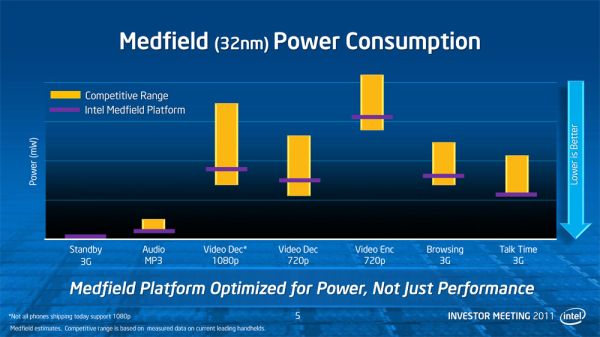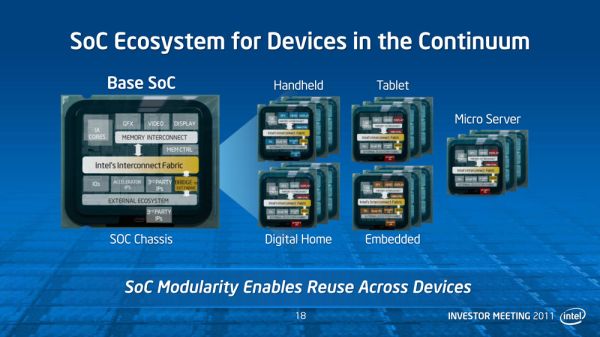Intel’s 2011 Investor Meeting - Intel’s Architecture Group: 14nm Airmont Atom In 2014
by Ryan Smith on May 17, 2011 6:27 PM ESTToday Intel is holding their annual investors meeting at their Santa Clara headquarters. In true Intel fashion it’s being treated as a big event (ed: it’s so big they ran out of lunch), as this is the company’s primary vehicle for addressing the investors holding their 125 billion dollars in shares; in essence it’s a reprise of their current and future technology plans as a pep-talk for investors. As such it’s not really a technical event, but it’s not uncommon for a few new technical details to shake out during the presentations.
There are a number of presentations throughout the day, including keynotes from Paul Otellini, and presentations from a number of Intel groups including the architecture group, the data center group, and the manufacturing group. If something is going to shake out it’s bound to be the architecture group, so this is where we’ll start.
Atom/SoC
A big part of the architecture group’s discussion focused on Atom/SoC. The 32nm Medfield Atom is due this year, so Intel has been laying out their plans for what they’re going to be doing with Medfield. Unsurprisingly, a big push with Medfield is to break into the SoC space in a way that Moorestown could not. Intel never managed any major design wins for smartphones with Moorestown, which is something they want to correct with Medfield. To that extent Intel has been showing off Medfield concept phones to show investors that it’s a viable product and to try to drum up support.

Intel's Medfield Concept Phone
Intel is also spending some effort to dispel the idea that they can’t be competitive on a power consumption basis; in fact for the amount of effort they put into that message and the number of times they repeated it, they seem to be seriously concerned about being perceived as uncompetitive. Intel did some power consumption testing on Medfield and put together a slide showing their findings that Medfield is competitive with some current leading phones, but as always take this with a pinch of salt. Ultimately this is a comparison of 32nm Medfield with 4Xnm ARM SoCs, so it’s only applicable so long as Intel’s still ahead of the ARM producers on manufacturing technology.
Moving on, one thing Intel has been dealing with as Atom has evolved is how to consolidate all the disparate parts of a system onto a SoC, given the wide variety of uses for a SoC. With discrete components manufacturers could simply build a device out of the parts necessary for the features they need, but with Atom SoCs much of that gets shifted onto Intel. For Intel this means they will be focusing on producing a wider variety of SoCs, based on building up individual SoC designs on a modular basis. Intel isn’t going in-depth on how many specific SoC variants they’re planning on offering, but our impression is that there will be many variants, similar to how Intel offers a number of different desktop/laptop/server CPUs based on a common architecture.
Finally, Intel published a new generalized roadmap for Atom through 2014. Unfortunately they aren’t going into any significant detail on architecture here – while Silvermont is named, nothing is confirmed besides the name and manufacturing process – but it’s a start, and it ends with a shocker. We will see Silvermont in 2013 on Intel’s 22nm process, likely hand-in-hand with Intel’s aforementioned plans for additional SoC variations.
Far more interesting however is that Intel didn’t stop with Silvermont on their Atom roadmap. Intel’s roadmap goes out to 2014 and includes Silvermont’s successor: Airmont. We know even less about Airmont than we do Silvermont, but a good guess would be that it’s the tick in Intel’s tick-tock cadence for Atom. The biggest news here is that with a move to tick-tock for Atom, Intel is finally accelerating the production of Atom parts on their newer fab processes. Currently Atom processors are a year or more behind Core processors for using a new process, and even with Silvermont that’s still going to be the case. But for Airmont that window is shrinking: Airmont will be released on Intel’s forthcoming 14nm process in 2014, the same year as their respective Core processor. Intel hasn’t specified when in 2014 this will be, and it’s likely it will still be months after 14nm launches for Core processors, but nevertheless it’s much sooner than it has been before.
By accelerating their production of Atom on new processes, this should allow Intel to capitalize on their manufacturing advantages over the rest of the fabs. With Intel’s existing Atom schedule, they only have a year or less before other fabs catch up with them, so by putting Atoms on new processes sooner, they increase that lead time. So far Intel’s ARM SoC competitors have really only had to deal with Intel’s threats on an architectural level, so having Intel challenge them at a manufacturing level too will make Intel a much more threatening competitor.
Core
Meanwhile, for the rest architecture group’s presentation, it was largely a catch-all for all of Intel’s consumer technologies. Much of the talk focused on where Intel plans to be in the next few years, based on where they expect to be thanks to their newly announced 22nm process. Intel considers their 22nm process to be a significant advantage for their products, so a great deal of their plans in the consumer space involve exploiting it in some manner or another.
Ivy Bridge, Intel’s first 22nm product, is being shown off in a few sample systems with Intel reiterating that it will be launching at the beginning of next year – we’d guess at CES. Longer term, Intel wants to get laptops closer to netbooks/tablets in terms of size and battery life, so that they can push 10 hours on a laptop (something the C2D-based Macbook Air can already get very close to). The catalyst for this will be Haswell, Intel’s new microarchitecture on their 22nm process scheduled for 2013.
Intel also used the occasion to show off a couple new technologies that they’re working on for Ivy Bridge generation computers. We’ve heard the name Fast Flash Standby mentioned before, but as far as we know this was the first time it has been demoed. In a nutshell, Fast Flash Standby is hibernating to SSDs, another product Intel has a significant interest in. The basis for Fast Flash Standby is that while going into sleep is fast, it requires leaving the RAM powered up to hold its contents, which is why sleep is only good for a few days of standby versus weeks for hibernation. Hibernating to a SSD, particularly one with a very high sequential read and write throughput, allows hibernation to take place much quicker and to resume much sooner. Intel is doing more here than just writing a hibernation file to a SSD, but the concept is similar.
Longer term Intel is looking at what kind of markets they want to go after, and what architectures they need to reach them. Intel is talking – albeit nebulously – about a new 10-20W notebook design target to sit right above their sub-10W target for Atom/SoC. Currently Intel offers CULV Sandy Bridge processors in the 10-20W range, but Intel appears to want to go beyond CULV with this new target. Whether this is a bulked up Atom, or a further trimmed IB/Haswell/Skylake remains to be seen. Intel is throwing around some performance targets however: they’re looking to improve iGPU performance by 12x over today’s performance in that 10-20W envelope.















63 Comments
View All Comments
JarredWalton - Thursday, May 19, 2011 - link
Sadly, "weeks of hibernation" is probably an apt description for most laptops. I've had a lot of laptops where the battery will discharge slowly just sitting on my desk, to where it will be pretty much dead after a month (and certainly after two). Sure, hibernation will still resume from where you left off, but the battery drain is irritating. Use better battery technology already, OEMs!Other than that, you're correct.
L. - Thursday, May 19, 2011 - link
Are you talking about permanently plugged in laptops ?Because my boss killed his n900 battery just like that.. and his laptop's too I think ...
JarredWalton - Thursday, May 19, 2011 - link
No, I'm talking about low quality Li batteries that just don't hold a charge. I've seen it with Dell, HP, Acer, Toshiba, Sony, etc. batteries. Simply put, all batteries are *not* created equal. Most of the business stuff, not surprisingly, is better than the consumer stuff. I just wish I could have a laptop battery that would hold 80% of its charge if left on the shelf for a year -- and I do have some Eneloop AA rechargeable batteries that will do exactly that.Interested Novice - Wednesday, May 18, 2011 - link
Do you mean 'of doubtful usage' if you already have an SSD in your PC? Obviously most smartphone and tablet users have an SSD but I expect the number of PC users that already have SSD-capability is very small. This seems like the best of both-worlds - a hybrid storage strategy that lets you enjoy the best of solid-state and HDD storage. That said I think the solution will be a commodity instead of something that Intel can differentiate, at least outside of the short-term.GullLars - Tuesday, May 24, 2011 - link
"I expect the number of PC users that _already_ have SSD-capability is very small"Already? I've had SSD for 3 years now. Most of my close family and friends for about 2 years. Everyone i game with online has had for at least a year. I suspect the line is drawn where people know that there is a storage device inside their computer, and it's not just magically a part of the box with the power button.
That said, the number of people who don't think this could be concidered small. I think about 10-15% of users. This will change as major laptop manufacturers start including SSDs as boot drives as default sometime in the next 1-3 years.
L. - Thursday, May 19, 2011 - link
I believe you are correct.Furthermore, if said disk is an SF-based disk, there's quite a chance it'll kill the Intel solution by a fair margin, there's usually a lot of replicated data within RAM (i.e. it's uncompressed).
Lucian Armasu - Wednesday, May 18, 2011 - link
Intel is just trying to capture some mindshare by announcing chips years ahead of launch. I don't think that will work. ARM is just one processing node behind Intel, so ARM chips will be at 28nm in 2012, and at 20nm in 2014.L. - Thursday, May 19, 2011 - link
Yup, and the fact is, at the same node, both AMD and ARM kill Intel single handedly.They'll need a big hit like the core architecture, but can they do it in low power and stuff.... I doubt it, they do NOT have GPU's, and they will have to either partner w/ nVidia or other people in order to compensate.
Not part of their slides (quite normal, that would change stock ratings) but it's their only way out.
DanNeely - Wednesday, May 18, 2011 - link
The old rule of thumb was always that an architecture was good for a bit under a 10x spread in power levels with the outer edges being somewhat ragged, like Intel's old extreme processors that were only marginally faster than the next lower powered bin or the ULV processors that took a massive performance hit vs the LV ones in the same family.I'm wondering if that's still true now as we continue to move to a many core model. If you design a core with a sweet spot in the 3-10W range, you can get 15W mobile quad cores for the low end, and 120W 12 core processors for high end servers out of the same architecture.
My suspicion is that a large part of how Intel intends to get power numbers for their mobile parts down to half their current range is going to be by making the IB mobile chips 22nm die shrinks of the current ones, and not bumping the core counts at each price point; and then repeating the no core count increases when Haswell launches.
L. - Thursday, May 19, 2011 - link
What an Insight ... lolJust kidding man, but have you seen the latest from AMD, and the next latest ? ^^